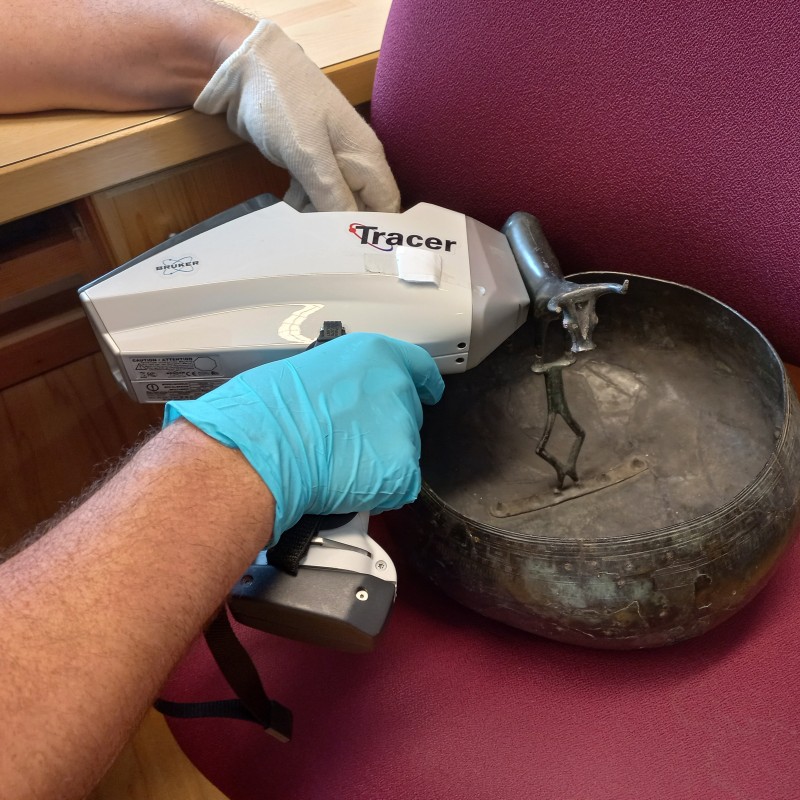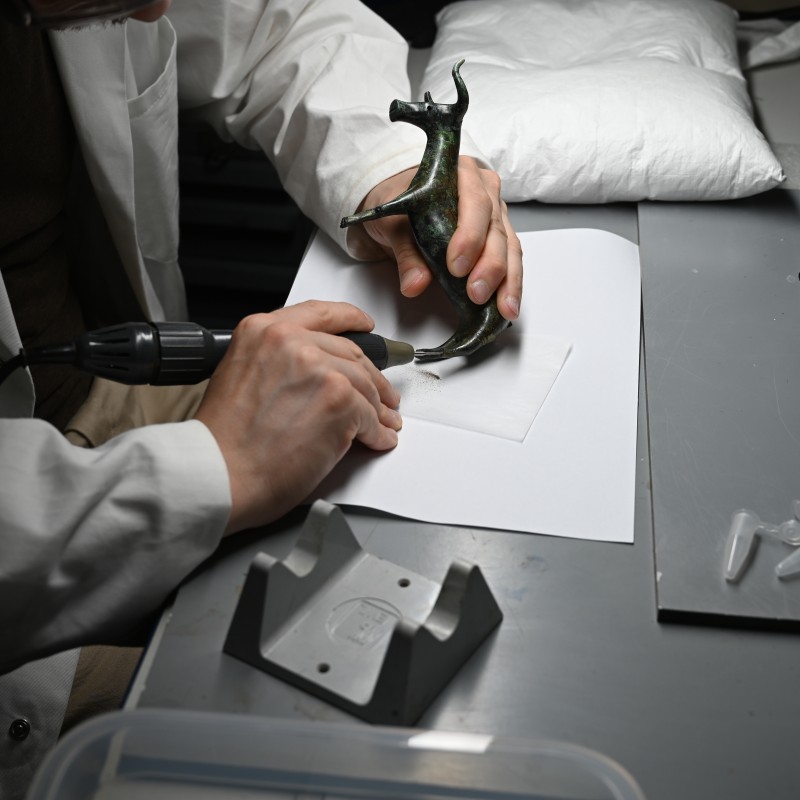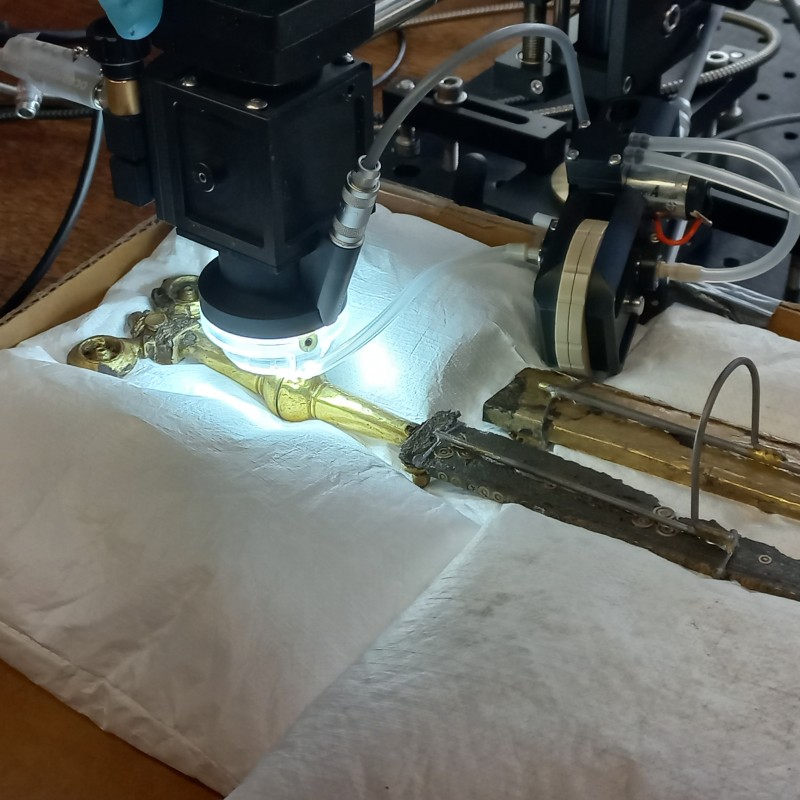Hallstatt: Far-reaching trade networks during the first millennium BC. Scientific analyses show that copper was brought to Hallstatt from Salzburg and the Southern Alps
30. January 2024
As part of a two-year
EU-funded project, archaeometallurgist Mathias Mehofer from the University of Vienna, together with colleagues from the Natural
History Museum Vienna, was able to systematically research the Iron Age metal trade in the Salzkammergut region of Upper Austria
and the Eastern Alps for the first time. The scientific analyses show that copper was not only brought to Hallstatt from Salzburg,
but also from the Southern Alps, where it was made into jewellery, weapons and tools.
The
demand for salt from Hallstatt stimulated far-reaching trade links and a lively exchange of valuable goods such as gold and
ivory as early as the Late Bronze and Iron Ages.
Working with Georg Tiefengraber and Karina Grömer from the Natural History Museum Vienna, Mathias Mehofer from the University of Vienna has examined burial objects from the 8th-4th centuries BC from the Hallstatt burial grounds to determine the origins of the metal.
By analysing the “geochemical fingerprint” of the copper, the scientists were able to show in this first pilot study that so-called chalcopyrite-based copper, possibly from Salzburg (Hochkönig-Mitterberg region) and the Southern Alps (Trentino, South Tyrol), was used during the Late Bronze Age (end of the second millennium BC), while pale ore-based metal was increasingly used in the following period (from around 900-800 BC). Research has yet to determine where this ore was mined in the first millennium BC.
“Our analyses therefore show that supply networks shifted over the centuries. Follow-up research is needed to determine where exactly the copper came from,” explains Mehofer. “One possible explanation is that the Late Bronze Age copper mines that supplied chalcopyrite copper were gradually exhausted and new sources of copper had to be tapped in order to keep operations in the salt mine running. The pale ore copper used subsequently has a much higher proportion of arsenic or antimony, both of which alter the properties of the copper.
The analyses also show that the tin content in the objects analysed declined over time, indicating a shortage of this important alloy component in tin bronze production. As the tin was obtained from distant locations such as England (Cornwall), Spain, Germany (the Erzgebirge region) or Central Asia, it is reasonable to conclude that these long-distance trade networks also evolved,” says Mehofer.
The metal was analysed using so-called X-ray fluorescence and mass spectrometer techniques. X-ray fluorescence analyses the quantity content of the main, secondary and trace elements in the metal, such as tin, lead or arsenic, while the mass spectrometer determines the lead isotope ratios of the copper, which are used to determine the origin of the raw metal. These methods finally made it possible to determine which mining regions the copper came from and how it was alloyed with tin to make bronze.
The scientists also conducted gold analyses, which are expected to provide important additional information on the metal trade. Portable laser ablation was used to take minimally invasive samples of the gold finds which were then analysed using a mass spectrometer at the Curt-Engelhorn Centre for Archaeometry in Mannheim. The scientists were able to identify which metal cycles the gold was obtained from and whether it is chemically comparable, for example, to gold from the Arikogel gold deposit located on the northern shore of Lake Hallstatt (on display in the Gold Cabinet of the Natural History Museum Vienna).
The testing of the physical materials will now be followed by a detailed analyses to contextualise the results.
“For the first time, these analyses will enable us to add important information to supplement existing findings on the complex trading activities of the Hallstatt miners,” explains Mehofer.
The metal finds themselves come from the graves. “The burial finds from Hallstatt in Upper Austria are among the most important archaeological finds in Europe,” says Karina Grömer, Director of the Prehistory Department at the NHM Vienna. “The Hallstatt site and the burial grounds near the salt mines, which contains spectacular burial objects, has also lent its name to an era in human history, the Hallstatt period in the Early Iron Age between 800 and 400 BC, thanks to its precious metal objects. The researchers at the NHM’s Prehistory Department are delighted to be able to lend their expertise and the bronze objects in their collections to further innovative research,” said Grömer.
It can be assumed that the work in the Hallstatt salt mine and the associated demand for tin bronze tools resulted in a constant influx of raw metal from the surrounding mining regions. In addition, the intensity of trading favoured the establishment of long-distance contacts due to the need for salt and salt-cured meat. Precious metal objects in the burial grounds, such as iron swords with ivory handles and amber inlays, are also indicative of such a network.
Symposium Hallstatt Culture from 9-11 May 2024
The Hallstatt Culture Symposium will take place 9-11 May, 2024 as part of the Bad Ischl Salzkammergut 2024 European Capital of Culture year and will be a joint event held in the Culture and Congress Centre in Hallstatt and organised by OÖ Landes-Kultur GmbH of Upper Austria and the Natural History Museum Vienna.
Both the underground research in the salt mine, carried out in close cooperation and support by Salinen Austria AG and Salzwelten GmbH, and the above-ground research in the burial grounds as well as the archaeological measures taken in the context of avalanche and torrent control play an important role. The symposium is dedicated to Dr. Anton Kern, a leading expert at the NHM Vienna for many years who recently passed away.
Details: www.ooekultur.at/event-detail/symposium-hallstatt-kultur
For further information on the research project:
HallMetals-Archaeometallurgical research on the Iron Age cemetery of Hallstatt, Austria (univie.ac.at)
Scientific enquiry note:
Dr. Ing. Mathias Mehofer
VIAS Vienna Institute for Archaeological Science,
Human Evolution and Archaeological Sciences, Universität Wien
mathias.mehofer@univie.ac.at
Dr. Georg Tiefengraber
Staff scientist, curator of the Bronze and Iron Age collection
https://www.nhm.at/georg_tiefengraber
Telefon: +43 1 52177-277
georg.tiefengraber@nhm.at
General enquiry:
Irina Kubadinow
Head of Press & Public Relations, Press spokesperson, NHM Vienna
https://www.nhm.at/irina_kubadinow
Tel.: + 43 (1) 521 77 DW 410
irina.kubadinow@nhm.at
Mag. Nikolett Kertész-Schenk, Bakk. BA MAS
Press & Public Relations, Press Officer, NHM Vienna
https://www.nhm.at/nikolett_kertesz
Tel.: + 43 (1) 521 77 DW 626
nikolett.kertesz@nhm.at
Working with Georg Tiefengraber and Karina Grömer from the Natural History Museum Vienna, Mathias Mehofer from the University of Vienna has examined burial objects from the 8th-4th centuries BC from the Hallstatt burial grounds to determine the origins of the metal.
By analysing the “geochemical fingerprint” of the copper, the scientists were able to show in this first pilot study that so-called chalcopyrite-based copper, possibly from Salzburg (Hochkönig-Mitterberg region) and the Southern Alps (Trentino, South Tyrol), was used during the Late Bronze Age (end of the second millennium BC), while pale ore-based metal was increasingly used in the following period (from around 900-800 BC). Research has yet to determine where this ore was mined in the first millennium BC.
“Our analyses therefore show that supply networks shifted over the centuries. Follow-up research is needed to determine where exactly the copper came from,” explains Mehofer. “One possible explanation is that the Late Bronze Age copper mines that supplied chalcopyrite copper were gradually exhausted and new sources of copper had to be tapped in order to keep operations in the salt mine running. The pale ore copper used subsequently has a much higher proportion of arsenic or antimony, both of which alter the properties of the copper.
The analyses also show that the tin content in the objects analysed declined over time, indicating a shortage of this important alloy component in tin bronze production. As the tin was obtained from distant locations such as England (Cornwall), Spain, Germany (the Erzgebirge region) or Central Asia, it is reasonable to conclude that these long-distance trade networks also evolved,” says Mehofer.
The metal was analysed using so-called X-ray fluorescence and mass spectrometer techniques. X-ray fluorescence analyses the quantity content of the main, secondary and trace elements in the metal, such as tin, lead or arsenic, while the mass spectrometer determines the lead isotope ratios of the copper, which are used to determine the origin of the raw metal. These methods finally made it possible to determine which mining regions the copper came from and how it was alloyed with tin to make bronze.
The scientists also conducted gold analyses, which are expected to provide important additional information on the metal trade. Portable laser ablation was used to take minimally invasive samples of the gold finds which were then analysed using a mass spectrometer at the Curt-Engelhorn Centre for Archaeometry in Mannheim. The scientists were able to identify which metal cycles the gold was obtained from and whether it is chemically comparable, for example, to gold from the Arikogel gold deposit located on the northern shore of Lake Hallstatt (on display in the Gold Cabinet of the Natural History Museum Vienna).
The testing of the physical materials will now be followed by a detailed analyses to contextualise the results.
“For the first time, these analyses will enable us to add important information to supplement existing findings on the complex trading activities of the Hallstatt miners,” explains Mehofer.
The metal finds themselves come from the graves. “The burial finds from Hallstatt in Upper Austria are among the most important archaeological finds in Europe,” says Karina Grömer, Director of the Prehistory Department at the NHM Vienna. “The Hallstatt site and the burial grounds near the salt mines, which contains spectacular burial objects, has also lent its name to an era in human history, the Hallstatt period in the Early Iron Age between 800 and 400 BC, thanks to its precious metal objects. The researchers at the NHM’s Prehistory Department are delighted to be able to lend their expertise and the bronze objects in their collections to further innovative research,” said Grömer.
It can be assumed that the work in the Hallstatt salt mine and the associated demand for tin bronze tools resulted in a constant influx of raw metal from the surrounding mining regions. In addition, the intensity of trading favoured the establishment of long-distance contacts due to the need for salt and salt-cured meat. Precious metal objects in the burial grounds, such as iron swords with ivory handles and amber inlays, are also indicative of such a network.
Symposium Hallstatt Culture from 9-11 May 2024
The Hallstatt Culture Symposium will take place 9-11 May, 2024 as part of the Bad Ischl Salzkammergut 2024 European Capital of Culture year and will be a joint event held in the Culture and Congress Centre in Hallstatt and organised by OÖ Landes-Kultur GmbH of Upper Austria and the Natural History Museum Vienna.
Both the underground research in the salt mine, carried out in close cooperation and support by Salinen Austria AG and Salzwelten GmbH, and the above-ground research in the burial grounds as well as the archaeological measures taken in the context of avalanche and torrent control play an important role. The symposium is dedicated to Dr. Anton Kern, a leading expert at the NHM Vienna for many years who recently passed away.
Details: www.ooekultur.at/event-detail/symposium-hallstatt-kultur
For further information on the research project:
HallMetals-Archaeometallurgical research on the Iron Age cemetery of Hallstatt, Austria (univie.ac.at)
Scientific enquiry note:
Dr. Ing. Mathias Mehofer
VIAS Vienna Institute for Archaeological Science,
Human Evolution and Archaeological Sciences, Universität Wien
mathias.mehofer@univie.ac.at
Dr. Georg Tiefengraber
Staff scientist, curator of the Bronze and Iron Age collection
https://www.nhm.at/georg_tiefengraber
Telefon: +43 1 52177-277
georg.tiefengraber@nhm.at
General enquiry:
Irina Kubadinow
Head of Press & Public Relations, Press spokesperson, NHM Vienna
https://www.nhm.at/irina_kubadinow
Tel.: + 43 (1) 521 77 DW 410
irina.kubadinow@nhm.at
Mag. Nikolett Kertész-Schenk, Bakk. BA MAS
Press & Public Relations, Press Officer, NHM Vienna
https://www.nhm.at/nikolett_kertesz
Tel.: + 43 (1) 521 77 DW 626
nikolett.kertesz@nhm.at




